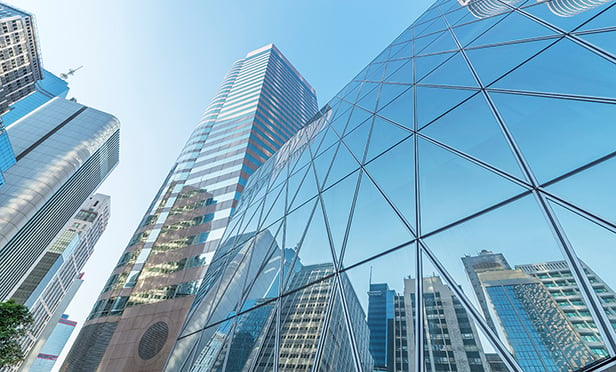SAN DIEGO—Los Angeles and Orange County have more central skyline markets, which become more of a hub for commerce and a center of gravity for local businesses versus San Diego's, which is less central and convenient for businesses, JLL EVP Misty Moore tells GlobeSt.com. According to a recent report from the firm, San Diego's lost decade for speculative- office development in Downtown has led to diminishing vacancy and upward pressure on rents.
The report also showed that skyline vacancy within the San Diego market remains below the national average at 11.2%, while rents in the first quarter remained consistent at $34.08 per square foot. Following four sales in 2016, 65% of San Diego's skyline office buildings have sold since the current recovery began in 2010.
Despite all the talk, 2017 is the 10th consecutive year to begin without any new speculative skyline office under construction in Downtown, though there is a 60,000-square-foot non-skyline office building that broke ground in May 2017. According to JLL research manager Jared Dienstag, “We continue to see a stabilization of vacancy rates to record levels in the San Diego skyline-office market putting upward pressure on rents. Lack of skyline-office development will keep occupancy levels in check.”
We spoke with Moore about why San Diego's office market is lagging behind others in Southern California and what the future looks like for this sector here.
GlobeSt.com: What are the factors that caused San Diego's skyline office market to lag behind others in Southern California?
Moore: San Diego is less of a corporate-headquarters market than L.A. or Orange County. Additionally, the vast majority of tenants in San Diego are below 10,000 square feet, which keeps tenants nimble and able to move around for better lease terms, which keeps rates low by forcing landlords to constantly compete for tenants. Lastly, in San Diego, our Downtown is in the southwest corner of all the primary office markets, which makes it less central and convenient for businesses. In L.A. and OC, you have more central skyline markets, which become more of a hub for commerce and a center of gravity for local businesses.
GlobeSt.com: What are the drivers for creative office in this market?
Moore: The new tech and media companies are driving occupancy in the skyline buildings and around Downtown. These companies tend to have higher populations of Millennial employees and more casual work environments than the typical finance, legal and insurance companies that used to dominate in Downtown. Most of those players continue to move north to UTC and Del Mar Heights. These new media companies have really been driving the trends we are seeing in creative-office use with greater focus on flexibility and amenities to build employee retention and satisfaction. We have truly created a live/work/play culture in Downtown, coupled with access to a younger workforce that is choosing to live Downtown, that many new companies are seeking.
GlobeSt.com: What does the future look like for San Diego's skyline-office sector?
Moore: With very little new office construction today, landlords stand to gain greater negotiating power due to the low vacancy rates. While some new construction is on the horizon, much of it can be delayed if market conditions do not justify the new square footage. Developers and owners have been more conservative in this upcycle and have really reigned in over-building, unlike the past peak market in 2004-2007. As the national commercial real estate fundamentals start to point towards the next down cycle, Downtown stays poised to resist this trend and at least delay its next downturn for a couple years, as long as new construction remains modest.
GlobeSt.com: What else should our readers know about this market?
Moore: Downtown rent growth has consistently lagged behind other submarkets through past peak cycles as core tenants moved out of the Downtown cul-de-sac and up to more central locations for their clients and employees. It's exciting to see Downtown finally have its day as a new wave of tenants seek out the urban environment and appreciating its walkable amenities, public transit and 24/7 lifestyle.
SAN DIEGO—Los Angeles and Orange County have more central skyline markets, which become more of a hub for commerce and a center of gravity for local businesses versus San Diego's, which is less central and convenient for businesses, JLL EVP Misty Moore tells GlobeSt.com. According to a recent report from the firm, San Diego's lost decade for speculative- office development in Downtown has led to diminishing vacancy and upward pressure on rents.
The report also showed that skyline vacancy within the San Diego market remains below the national average at 11.2%, while rents in the first quarter remained consistent at $34.08 per square foot. Following four sales in 2016, 65% of San Diego's skyline office buildings have sold since the current recovery began in 2010.
Despite all the talk, 2017 is the 10th consecutive year to begin without any new speculative skyline office under construction in Downtown, though there is a 60,000-square-foot non-skyline office building that broke ground in May 2017. According to JLL research manager Jared Dienstag, “We continue to see a stabilization of vacancy rates to record levels in the San Diego skyline-office market putting upward pressure on rents. Lack of skyline-office development will keep occupancy levels in check.”
We spoke with Moore about why San Diego's office market is lagging behind others in Southern California and what the future looks like for this sector here.
GlobeSt.com: What are the factors that caused San Diego's skyline office market to lag behind others in Southern California?
Moore: San Diego is less of a corporate-headquarters market than L.A. or Orange County. Additionally, the vast majority of tenants in San Diego are below 10,000 square feet, which keeps tenants nimble and able to move around for better lease terms, which keeps rates low by forcing landlords to constantly compete for tenants. Lastly, in San Diego, our Downtown is in the southwest corner of all the primary office markets, which makes it less central and convenient for businesses. In L.A. and OC, you have more central skyline markets, which become more of a hub for commerce and a center of gravity for local businesses.
GlobeSt.com: What are the drivers for creative office in this market?
Moore: The new tech and media companies are driving occupancy in the skyline buildings and around Downtown. These companies tend to have higher populations of Millennial employees and more casual work environments than the typical finance, legal and insurance companies that used to dominate in Downtown. Most of those players continue to move north to UTC and Del Mar Heights. These new media companies have really been driving the trends we are seeing in creative-office use with greater focus on flexibility and amenities to build employee retention and satisfaction. We have truly created a live/work/play culture in Downtown, coupled with access to a younger workforce that is choosing to live Downtown, that many new companies are seeking.
GlobeSt.com: What does the future look like for San Diego's skyline-office sector?
Moore: With very little new office construction today, landlords stand to gain greater negotiating power due to the low vacancy rates. While some new construction is on the horizon, much of it can be delayed if market conditions do not justify the new square footage. Developers and owners have been more conservative in this upcycle and have really reigned in over-building, unlike the past peak market in 2004-2007. As the national commercial real estate fundamentals start to point towards the next down cycle, Downtown stays poised to resist this trend and at least delay its next downturn for a couple years, as long as new construction remains modest.
GlobeSt.com: What else should our readers know about this market?
Moore: Downtown rent growth has consistently lagged behind other submarkets through past peak cycles as core tenants moved out of the Downtown cul-de-sac and up to more central locations for their clients and employees. It's exciting to see Downtown finally have its day as a new wave of tenants seek out the urban environment and appreciating its walkable amenities, public transit and 24/7 lifestyle.
Want to continue reading?
Become a Free ALM Digital Reader.
Once you are an ALM Digital Member, you’ll receive:
- Breaking commercial real estate news and analysis, on-site and via our newsletters and custom alerts
- Educational webcasts, white papers, and ebooks from industry thought leaders
- Critical coverage of the property casualty insurance and financial advisory markets on our other ALM sites, PropertyCasualty360 and ThinkAdvisor
Already have an account? Sign In Now
*May exclude premium content© 2024 ALM Global, LLC, All Rights Reserved. Request academic re-use from www.copyright.com. All other uses, submit a request to [email protected]. For more information visit Asset & Logo Licensing.









